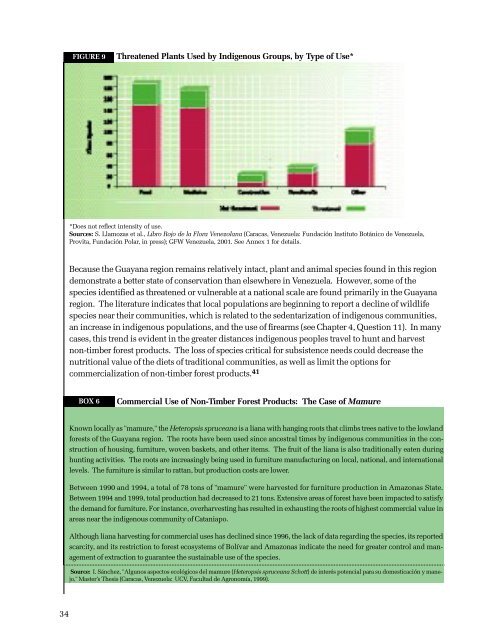Usar pâgs xvii-134 - ResearchGate
Usar pâgs xvii-134 - ResearchGate
Usar pâgs xvii-134 - ResearchGate
Create successful ePaper yourself
Turn your PDF publications into a flip-book with our unique Google optimized e-Paper software.
FIGURE 9Threatened Plants Used by Indigenous Groups, by Type of Use**Does not reflect intensity of use.Sources: S. Llamozas et al., Libro Rojo de la Flora Venezolana (Caracas, Venezuela: Fundación Instituto Botánico de Venezuela,Provita, Fundación Polar, in press); GFW Venezuela, 2001. See Annex 1 for details.Because the Guayana region remains relatively intact, plant and animal species found in this regiondemonstrate a better state of conservation than elsewhere in Venezuela. However, some of thespecies identified as threatened or vulnerable at a national scale are found primarily in the Guayanaregion. The literature indicates that local populations are beginning to report a decline of wildlifespecies near their communities, which is related to the sedentarization of indigenous communities,an increase in indigenous populations, and the use of firearms (see Chapter 4, Question 11). In manycases, this trend is evident in the greater distances indigenous peoples travel to hunt and harvestnon-timber forest products. The loss of species critical for subsistence needs could decrease thenutritional value of the diets of traditional communities, as well as limit the options forcommercialization of non-timber forest products. 41BOX 6Commercial Use of Non-Timber Forest Products: The Case of MamureKnown locally as "mamure," the Heteropsis spruceana is a liana with hanging roots that climbs trees native to the lowlandforests of the Guayana region. The roots have been used since ancestral times by indigenous communities in the constructionof housing, furniture, woven baskets, and other items. The fruit of the liana is also traditionally eaten duringhunting activities. The roots are increasingly being used in furniture manufacturing on local, national, and internationallevels. The furniture is similar to rattan, but production costs are lower.Between 1990 and 1994, a total of 78 tons of "mamure" were harvested for furniture production in Amazonas State.Between 1994 and 1999, total production had decreased to 21 tons. Extensive areas of forest have been impacted to satisfythe demand for furniture. For instance, overharvesting has resulted in exhausting the roots of highest commercial value inareas near the indigenous community of Cataniapo.Although liana harvesting for commercial uses has declined since 1996, the lack of data regarding the species, its reportedscarcity, and its restriction to forest ecosystems of Bolívar and Amazonas indicate the need for greater control and managementof extraction to guarantee the sustainable use of the species.Source: I. Sánchez, "Algunos aspectos ecológicos del mamure (Heteropsis spruceana Schott) de interés potencial para su domesticación y manejo,"Master’s Thesis (Caracas, Venezuela: UCV, Facultad de Agronomía, 1999).34
















